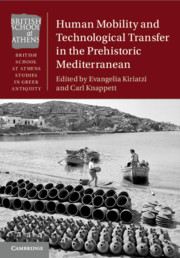Book contents
- Human Mobility and Technological Transfer in the Prehistoric Mediterranean
- British School at Athens Studies in Greek Antiquity
- Human Mobility and Technological Transfer in the Prehistoric Mediterranean
- Copyright page
- Contents
- Figures and Maps
- Tables
- Contributors
- Foreword
- Acknowledgements
- 1 Technological Mobilities: Perspectives from the Eastern Mediterranean – An Introduction
- 2 The Transmitting Sea: A Mediterranean Perspective
- 3 Changing Pottery Technology in the Later Neolithic in Macedonia, North Greece
- 4 Mobility and Early Bronze Age Southern Aegean Metal Production
- 5 Stonemasons and Craft Mobility in the Bronze Age Eastern Mediterranean
- 6 Towards an Understanding of the Origin of Late Bronze Age Greek Glass
- 7 Mobilities in the Neopalatial Southern Aegean: The Case of Minoanisation
- 8 The Archaeological Signatures of Mobility: A Technological Look at ‘Aegeanising’ Pottery from the Northern Levant at the End of the 2nd Millennium BC
- 9 Mycenaean and Mycenaeanising Pottery across the Mediterranean: A Multi-Scalar Approach to Technological Mobility, Transmission and Appropriation
- 10 Interpreting Bronze Age Trade and Migration
- 11 Commentary: States and Technological Mobility – A View from the West
- 12 Commentary: On Fluxes, Connections and their Archaeological Manifestations
- Bibliography
- Index
- References
Bibliography
Published online by Cambridge University Press: 21 January 2017
- Human Mobility and Technological Transfer in the Prehistoric Mediterranean
- British School at Athens Studies in Greek Antiquity
- Human Mobility and Technological Transfer in the Prehistoric Mediterranean
- Copyright page
- Contents
- Figures and Maps
- Tables
- Contributors
- Foreword
- Acknowledgements
- 1 Technological Mobilities: Perspectives from the Eastern Mediterranean – An Introduction
- 2 The Transmitting Sea: A Mediterranean Perspective
- 3 Changing Pottery Technology in the Later Neolithic in Macedonia, North Greece
- 4 Mobility and Early Bronze Age Southern Aegean Metal Production
- 5 Stonemasons and Craft Mobility in the Bronze Age Eastern Mediterranean
- 6 Towards an Understanding of the Origin of Late Bronze Age Greek Glass
- 7 Mobilities in the Neopalatial Southern Aegean: The Case of Minoanisation
- 8 The Archaeological Signatures of Mobility: A Technological Look at ‘Aegeanising’ Pottery from the Northern Levant at the End of the 2nd Millennium BC
- 9 Mycenaean and Mycenaeanising Pottery across the Mediterranean: A Multi-Scalar Approach to Technological Mobility, Transmission and Appropriation
- 10 Interpreting Bronze Age Trade and Migration
- 11 Commentary: States and Technological Mobility – A View from the West
- 12 Commentary: On Fluxes, Connections and their Archaeological Manifestations
- Bibliography
- Index
- References
- Type
- Chapter
- Information
- Publisher: Cambridge University PressPrint publication year: 2016



